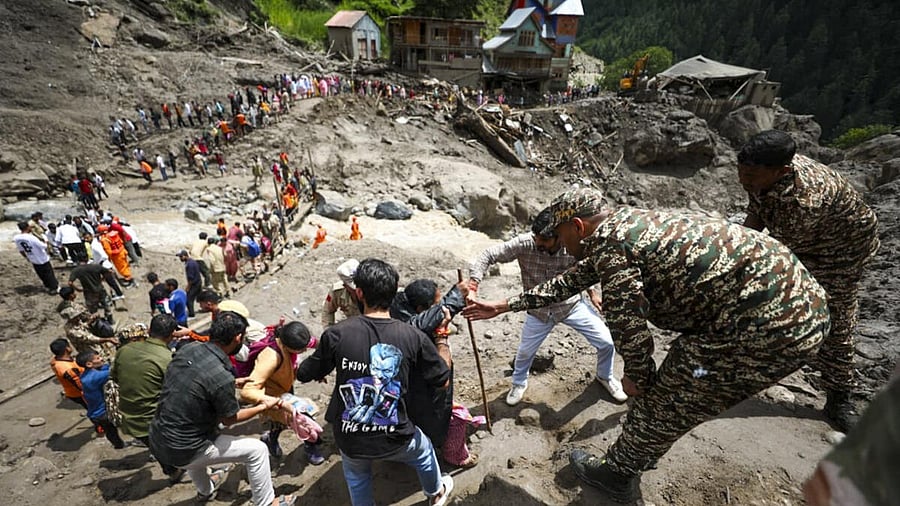
Rescue work underway at an affected area following a cloudburst, in Kishtwar district, Jammu and Kashmir, Friday, Aug. 15, 2025. At least 60 people were killed in the incident, according to officials.
Credit: PTI Photo
Mumbai: As Jammu & Kashmir reel under heavy rainfall, weather and sustainability experts have revealed that the Himalayan belt is reeling under the impact of climate change.
"August is the peak monsoon month; thus, heavy rainfall is not unusual at this point. The axis of the Monsoon trough is currently passing through the foothills of the Himalayas along with a western disturbance over the region. However, we now need to focus on the infrastructure in the region. These inclement weather events will persist, in fact, increase due to global warming. The land is already saturated because of the continuous downpour for the last many days. Deforestation in the region has led to weakened slopes, making them more susceptible to landslides and mudslides,” said Mahesh Palawat, Vice President, Meteorology and Climate Change, Skymet Weather.
“While it is yet to be ascertained whether it was a cloudburst, in such prevailing conditions, even a heavy downpour of 50 mm-60 mm can trigger such an extreme event. Also, the number of glacial lakes has been increasing due to climate change across the Himalayan region. Since these lakes are not centuries old, the glacial lake edges are very unstable and prone to erosion, melting, and sudden failures. Whenever there is a spell of heavy rains, water tends to overflow and bring down slush and unconsolidated sediments, causing more damage downstream as we have witnessed in Uttarakhand and now in Kashmir,” added Palawat.
“The Himalayas are eco-sensitive zones, and a distinct pattern is emerging in the region. Due to global warming, the water content in the atmosphere has increased. Average precipitation data alone cannot indicate whether an extreme event is likely,” added Prof Sachchida Nand Tripathi Dean, Kotak School of Sustainability, Indian Institute of Technology-Kanpur.
“The Himalayas are eco-sensitive zones, and a distinct pattern is emerging in the region. Due to global warming, the water content in the atmosphere has increased. Average precipitation data alone cannot indicate whether an extreme event is likely. Topographically, the Himalayas comprise a series of diverse hill ranges that have a profound effect on weather patterns. One major factor is orographic rainfall—when moist air is forced to rise over the mountains, cooling and condensing into heavy precipitation. To predict such rainfall accurately in this complex terrain, we need systems capable of capturing the "mountain effect" with precision. A second concern is that many glaciers have partially melted. With ongoing rainfall, lakes and other water bodies are filled to capacity, making them prone to sudden bursts that can unleash floods in inhabited areas.,” he added.
“It is established that under the climate change scenario, cloudburst or cloudburst-like conditions are increasing in the Himalayan region due to increased moisture content from abnormal warming of oceans. For every degree rise in temperature, the atmosphere’s capacity to hold moisture increases by approximately seven percent. Cloud conditions have changed due to atmospheric instability,” added Kartiki Negi, Lead, Climate Impacts, Climate Trends.
“The Himalayas serve as natural barriers, forcing moist air upward and leading to the formation of towering convective clouds, known as Cumulonimbus clouds, holding vast amounts of water. When confined by mountainous terrain, they can unleash intense rainfall over a small area in the short period,” added Negi.